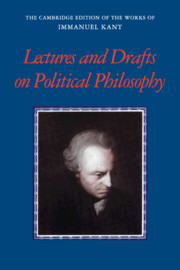Book contents
- Frontmatter
- Contents
- General Editors’ Preface
- Acknowledgments
- General Introduction
- Translators’ Remarks
- Reflections on the Philosophy of Right
- Natural Right Course Lecture Notes by Feyerabend
- Drafts for Published Works
- Drafts for Theory and Practice
- Drafts for Towards Perpetual Peace
- Drafts for the Metaphysics of Morals
- Drafts for Conflict of the Faculties
- Glossary
- Topical and Chronological Concordance
- Editorial Notes
- Index
Editor’s Introduction
Published online by Cambridge University Press: 10 December 2020
- Frontmatter
- Contents
- General Editors’ Preface
- Acknowledgments
- General Introduction
- Translators’ Remarks
- Reflections on the Philosophy of Right
- Natural Right Course Lecture Notes by Feyerabend
- Drafts for Published Works
- Drafts for Theory and Practice
- Drafts for Towards Perpetual Peace
- Drafts for the Metaphysics of Morals
- Drafts for Conflict of the Faculties
- Glossary
- Topical and Chronological Concordance
- Editorial Notes
- Index
Summary
Kant thought of improvements to his approach to ideal political relations soon after his essay “Theory and Practice” appeared before the reading public in the famous Berlinische Monatsschrift in September 1793. Likely within a month he penned a fragment he titled “Something on the relation of theory to practice” (F 23 below) that discusses theory and practice (treated in the newly published essay) as well as the republican type of government (treated only later in Towards Perpetual Peace). Between that time and August 13, 1795, when Kant wrote to the printer Friedrich Nicolovius that he would send a manuscript for a new book before the end of the week that Nicolovius could publish for the next book fair (12:35), Kant formulated what would become his most sustained look at international relations and the possibility of peace based on republicanism, a federalism among states, and cosmopolitanism. During that time he gave no indication in any surviving letters or other sources that he was working on a book on the topic, so it is unclear precisely when he decided to transform his afterthoughts into preparatory drafts. Scholars have long suggested that the Peace of Basel between France and Prussia, signed April 5, 1795, was the immediate trigger for Kant's decision to create the new publication. While it could be that Kant took the opportunity provided by that decidedly non-perpetual peace to complete his work for publication, he may have had the short book in mind long beforehand. The topic concerning international structures to ensure peace had been brought to prominence in 1713 by the Abbé St. Pierre, who inspired many others over the following decades and whose proposals Kant knew of for most of his career.
The drafts translated here range from the early one discussing theory and practice to parts of the Reinschrift that did not make it into the final published version. Dating of these drafts is not included in the Academy edition but is taken from Werner Stark's study of this material, mentioned in the general introduction.
- Type
- Chapter
- Information
- Kant: Lectures and Drafts on Political Philosophy , pp. 205 - 206Publisher: Cambridge University PressPrint publication year: 2016

